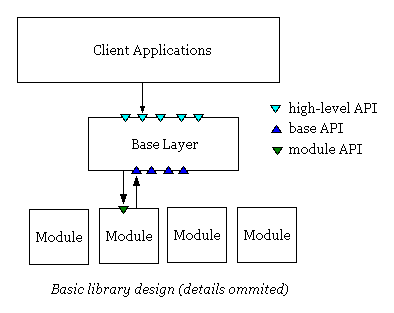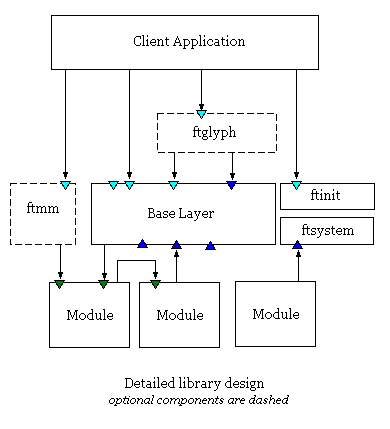FreeType 2 Modules
The purpose of this document is to present in great details the way FreeType 2 uses and manages modules. Among other things, it answers the following questions:
1. Library design:The design of the library is pretty basic:
This is illustrated by the following graphics:  Note that, however, FT2 comes with a set of optional components that can be ommited from certain builds, and whose purpose vary between two situations:
This is illustrated by the following graphics: 
The library is capable of managing and using several kinds of modules:
We will now study how modules are described, then managed by the library. 1. The FT_Module_Class structure:As described later in this document, library initialisation is performed by calling the FT_Init_FreeType function. The latter is in charge of creating a new "empty" FT_Library object, then register each "default" module by repeatedly calling the FT_Add_Module function. Similarly, client applications can call FT_Add_Module any time they wish in order to register a new module in the library. Let's take a look at this function's declaration:
extern FT_Error FT_Add_Module( FT_Library library,
const FT_Module_Class* clazz );
As one can see, this function expects a handle to a library object, as well as a pointer to a FT_Module_Class structure. It returns an error code. In case of success, a new module object is created and added to the library. Note by the way that the module isn't returned directly by the call !. Let's study the definition of FT_Module_Class, and explain it a bit. The following code is taken from <freetype/ftmodule.h>:
typedef struct FT_Module_Class_
{
FT_ULong module_flags;
FT_Int module_size;
const FT_String* module_name;
FT_Fixed module_version;
FT_Fixed module_requires;
const void* module_interface;
FT_Module_Constructor module_init;
FT_Module_Destructor module_done;
FT_Module_Requester get_interface;
} FT_Module_Class;
here's a description of its fields:
2. The FT_Module type:the FT_Module type is a handle (i.e. a pointer) to a given module object / instance, whose base structure is given by the internal FT_ModuleRec type (we will not detail its structure here). When FT_Add_Module is called, it first allocate a new module instance, using the module_size class field to determine its byte size. The function initializes a the root FT_ModuleRec fields, then calls the class-specific initializer module_init when this field is not set to NULL.
As said previously, renderers are used to convert scalable glyph images to bitmaps or pixmaps. Each renderer module is defined through a renderer class, whose definition is found in the file <freetype/ftrender.h>. However, a few concepts need to be explained before having a detailed look at this structure. 1. Glyph formats:Each glyph image that is loaded by FreeType (either through FT_Load_Glyph or FT_Load_Char), has a given image format, described by the field face->glyph->format. It is a 32-byte integer that can take any value. However, the file <freetype/ftimage.h> defines at least the following values:
Note that this is only a list of pre-defined formats supported by FreeType. Nothing prevents an application to install a new font driver that creates other kinds of glyph images. For example, one could imagine a MetaFont font driver, that would be capable to parse font definition files and create in-memory "glyph programs", that could be returned in face->glyph->other. 2. The FT_Outline type:This structure, which is also defined, and heavily commented, in the file <freetype/ftimage.h>, is used to hold a scalable glyph image that is made of one or more contours, each contour being described by line segments or bezier arcs (either quadratic or cubic). The outline itself is stored in a compact way that makes processing it easy. Points are placed in a 2D plane that uses the y-upwards convention, and their coordinates are stored in 1/64th of pixels (also known as the 26.6 fixed point format). Pixels correspond to single squares whose borders are on integer coordinates (i.e. mutiples of 64). In other words, pixel centers are located on half pixel coordinates. Outlines can be very easily transformed (translated, rotated, etc..) before being converted to bitmap, which allows for sophisticated use of text. FreeType 2 comes by default with two "outline renderer" modules:
3. Bitmaps and scan-conversion:Bitmaps and pixmaps are described through a FT_Bitmap structure, which is defined and heavily commented in <freetype/ftimage.h>
typedef struct FT_Renderer_Class_
{
FT_Module_Class root;
FT_Glyph_Format glyph_format;
FTRenderer_render render_glyph;
FTRenderer_transform transform_glyph;
FTRenderer_getCBox get_glyph_cbox;
FTRenderer_setMode set_mode;
FT_Raster_Funcs* raster_class;
} FT_Renderer_Class;
By default, all components of FreeType 2 are compiled independently, then grouped into a single static library file that can be installed or used directly to compile client applications Such applications must normally call the FT_Init_FreeType function before using the library. This function is in charge of two things:
It is important to notice that the default implementation of FT_Init_FreeType, which is located in the source file "src/base/ftinit.c" always uses a static list of modules that is generated at compile time from the configuration file <freetype/config/ftmodule.h>. There are cases where this may be inadequate. For example, one might want to compile modules as independent DLLs in a specific location (like "/usr/lib/freetype/module/"), and have the library initialisation function load the modules dynamically by parsing the directory's content This is possible, and we're going to explain how to do it. a. Building the library as a DLL (i.e. "shared object" on Unix)But first of all, let's explain how to build FreeType 2 as a single DLL or shared object, i.e. one that includes the base layer, all default modules and optional components into a single file. When building dynamic libraries, certain compilers require specific directives to declare exported DLL entry points. For example, the "__cdecl" directive is required by Win32 compilers, as it forces the use of the "C" parameter passing convention (instead of "smarter" schemes, which usually use registers and the stack to pass parameters). To make matter worse, some of these compilers require the directive before the function's return type, while some others want it between the return type and the function's identifier. To allow such compilations, the FT_EXPORT_DEF() macro is used in all public header files in order to declare each high-level API function of FreeType 2, as in the following example, taken from <freetype/freetype.h>: FT_EXPORT_DEF(FT_Error) FT_Init_FreeType( void ); the definition of FT_EXPORT_DEF(x) defaults to "extern x", except when a specific definition is given in the library's system-specific configuration file <freetype/config/ftconfig.h>. This allows project builders to specify the exact compilation directive they need. Similarly, the FT_EXPORT_FUNC(x) macro is defined and used to define exported functions within the FreeType 2 source code. However, it is only used at compilation time. Note that on Unix, there is no need for specific exportation directives. However, the code must be compiled in a special way, named Position Independent Code ("PIC"), which is normally selected through specific compiler flags (like "-PIC" with gcc). b. Building modules as DLLsIn order to build modules as dynamic libraries, we first need to compile the base layer (and optional components) as a single DLL. This is very similar to the case we just described, except that we also need to export all functions that are part of the "low level base API", as these will get called by the modules in various cases. Similarly to the high-level API, all functions of the low-level base API are declared in the internal header files of FreeType 2 with the BASE_DEF(x) macro. The latter is similar to FT_EXPORT_DEF and defaults to "extern x" unless you specify a specific definition in <freetype/config/ftconfig.h>.
|